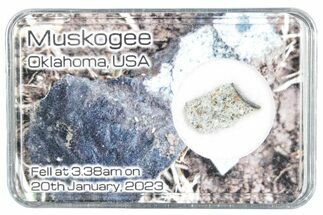This Specimen has been sold.
4.4" Dimmitt Chondrite Meteorite (493 g) - Texas
This is an uncut, 493 gram Dimmitt chondrite meteorite from Texas. It measures 4.4 x 2.85 x 2" and comes with an acrylic display stand.
The Dimmitt Meteorite
The Dimmitt meteorite fell during prehistoric times and was discovered in 1942 in Castro County, Texas. Around 200 kilograms of material were recovered from a 25-mile long strewn field. The largest collection of Dimmitt material is held at the University of New Mexico Institute of Meteoritics.
This meteorite is classified as an ordinary chondrite (H3.7) and is a regolith breccia from the surface of its parent asteroid. It contains fragments of other meteorite types (LL, carbonaceous, and others) from various bodies that impacted and mixed into the surface of that asteroid. While chondrites are the most common class of meteorite, only 75 meteorites are classified as H3.7 chondrites. The majority come from Antarctica and are largely unattainable.
Fun Fact: Microscopic diamonds have also been found in the Dimmitt meteorite, making it a particularly cool find!
The Dimmitt meteorite fell during prehistoric times and was discovered in 1942 in Castro County, Texas. Around 200 kilograms of material were recovered from a 25-mile long strewn field. The largest collection of Dimmitt material is held at the University of New Mexico Institute of Meteoritics.
This meteorite is classified as an ordinary chondrite (H3.7) and is a regolith breccia from the surface of its parent asteroid. It contains fragments of other meteorite types (LL, carbonaceous, and others) from various bodies that impacted and mixed into the surface of that asteroid. While chondrites are the most common class of meteorite, only 75 meteorites are classified as H3.7 chondrites. The majority come from Antarctica and are largely unattainable.
Fun Fact: Microscopic diamonds have also been found in the Dimmitt meteorite, making it a particularly cool find!
About Chondrites
Chondrites are stony (non-metallic) meteorites that have not been modified by either melting or differentiation of the parent body. They are formed when various types of dust and small grains in the early Solar System accreted to form primitive asteroids. Some such bodies are captured in the planet’s gravity well and pulled to the surface. They are by far the most common type of meteorite, representing about 86 percent of all meteorites that have fallen to Earth.
Prominent among the components present in chondrites are the enigmatic chondrules, millimeter-sized spherical objects that originated as freely floating, molten or partially molten droplets in space; most chondrules are rich in the silicate minerals olivine and pyroxene. Chondrites also contain particles of various metals such as nickel, iron, and aluminum. These formed at the very beginning of the solar system and aggregated over time: they are the oldest rocks known on Earth!
Chondrites are divided into about fifteen distinct groups on the basis of their mineralogy, bulk chemical composition, and oxygen isotope compositions. The various chondrite groups likely originated on separate asteroids or groups of related asteroids. Each chondrite group has a distinctive mixture of chondrules, refractory inclusions, matrix (dust), characteristic chondrule sizes, and other components. Other ways of classifying chondrites include weathering and shock. The L chondrite group is the most common of these.
Chondrites are stony (non-metallic) meteorites that have not been modified by either melting or differentiation of the parent body. They are formed when various types of dust and small grains in the early Solar System accreted to form primitive asteroids. Some such bodies are captured in the planet’s gravity well and pulled to the surface. They are by far the most common type of meteorite, representing about 86 percent of all meteorites that have fallen to Earth.
Prominent among the components present in chondrites are the enigmatic chondrules, millimeter-sized spherical objects that originated as freely floating, molten or partially molten droplets in space; most chondrules are rich in the silicate minerals olivine and pyroxene. Chondrites also contain particles of various metals such as nickel, iron, and aluminum. These formed at the very beginning of the solar system and aggregated over time: they are the oldest rocks known on Earth!
Chondrites are divided into about fifteen distinct groups on the basis of their mineralogy, bulk chemical composition, and oxygen isotope compositions. The various chondrite groups likely originated on separate asteroids or groups of related asteroids. Each chondrite group has a distinctive mixture of chondrules, refractory inclusions, matrix (dust), characteristic chondrule sizes, and other components. Other ways of classifying chondrites include weathering and shock. The L chondrite group is the most common of these.
TYPE
Chondrite (H3.7)
LOCATION
Dimmitt, Texas
SIZE
4.4 x 2.85 x 2", 493 grams
CATEGORY
ITEM
#263173
 Reviews
Reviews













